Safety is always the number one concern for all workers on a jobsite, regardless of industry. From mining to concrete production, to theme park construction, there has always been a continual effort in the construction industry to improve worker safety. Mobile technologies, construction wearables, and even Artificial Intelligence (AI) are being introduced to more and more jobsites to help create a safer work environment while maintaining (if not improving) productivity.
Nearly every modern jobsite takes advantage of mobile technologies in the form of phones, laptops, and tablets with built-in cellular connectivity.
Workers are able to provide better communication, real-time data, and documentation with digital signatures and global positioning system (GPS) tags to ensure authenticity. The use of mobile devices also reduces the amount of data entry required for tasks and reduces the need for hard copy documents, saving countless hours of redundancy over the life of the project. Employees are able to submit timecards, daily reports, request for information (RFI), and other documents without leaving the site.
Mobile technology and cloud-based solutions allow everyone on a project to be able to review and update documents, reports, plans, and specifications in real-time, keeping everyone on the same page as work progresses. However, more and more accidents and incidents are occurring on jobsites attributed to workers being distracted by a mobile device. Studies show that an estimated 70% of employees keep their phones “within eye contact” at work. A recent survey polled over 1,000 US workers about workplace incidents/accidents, among respondents working in the industrial setting, 26% of respondents indicated that at least one workplace accident had occurred due to an employee being distracted by a mobile device, with 75% of those incidents causing property damage, and 58% of the incidents causing injury or death.
To address this issue, construction wearables are becoming more common on jobsites. Workers are utilizing smart watches with 5g connectivity to allow hands-free communication between employees, supervisors, and office personnel without the physical or visual distraction of a cellphone or tablet. Some watches are also able to monitor workers’ health information/heartrate, activity and location and can detect an emergency.
High visibility vests are another great example of wearable technology that is required on nearly every jobsite regardless of the industry.
While increasing visibility of workers is a critical benefit alone, vests are now able to be equipped with GPS monitoring systems that can alert the wearer of entry into a dangerous or restricted area, allow safety personnel and supervisors to monitor the location of crew members on large, spread-out jobsites, and can even communicate with GPS-enabled equipment that will stop all operations in the event a worker is detected in its work path.
In addition to worker safety, the physical safety and security of jobsites, construction facilities, and laydown yards are being kept safer and secure with the implementation of various mobile technologies.
Wireless camera systems operating on a cellular network are able to stream live video to mobile devices. Portable alarm systems equipped with motion, heat, and impact sensors, and GPS monitoring of equipment and materials are being used to secure jobsites, reducing workplace injuries, and limiting potential liability. Even AI, paired with video monitoring systems, is being used to increase worker and jobsite safety. AI can be used with video monitoring systems in dangerous work environments to determine if employees are missing critical personal protective equipment (PPE). It can restrict the operation of equipment in populated locations and provide real-time reporting in preparation for Occupational Safety and Health Administration (OSHA) required documentation.
These, and many other rapid advancements in mobile and construction technology are improving safety, reducing injuries, and improving the flow of information on construction projects. The implementation and use of these technologies can assist employees in being more productive, efficient, and proactive, while providing a safer and more secure jobsite.

